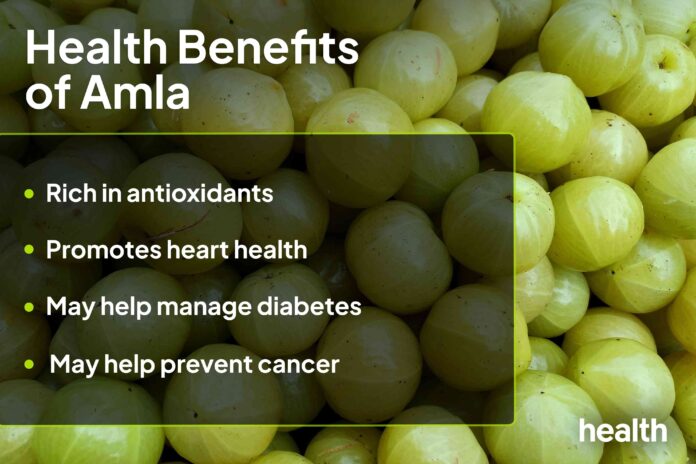Amla, also known as Indian gooseberry (Phyllanthus emblica), is a small, green fruit that packs a powerful punch when it comes to nutrition. While its tart flavor might not be for everyone fresh off the branch, amla has long held a prominent place in traditional Ayurvedic medicine and is gaining increasing recognition in modern health circles for its impressive range of potential benefits.
So, what makes this little fruit so special? Let’s delve into five key advantages backed by scientific research:
1. Diabetes Management
Amla stands out as a potential ally in managing diabetes thanks to its rich antioxidant profile. Compounds like flavonoids, polyphenols, vitamins, and minerals work synergistically to combat oxidative stress within the body. This protective effect helps slow down the breakdown of carbohydrates – a crucial factor in regulating blood sugar levels. By mitigating this breakdown, amla may support the pancreas in producing sufficient insulin, the hormone responsible for ushering glucose into cells and effectively lowering blood sugar.
2. A Powerful Immunity Booster
With a vitamin C content exceeding that of citrus fruits like grapes, limes, and apples, it’s no surprise that amla is celebrated as an immunity powerhouse. But its benefits extend beyond this single nutrient. Amla also boasts a remarkable array of other antioxidants – tannins, alkaloids, and polyphenols including gallic acid, ellagic acid, and various flavonoids – further bolstering its defense against cellular damage. These compounds work tirelessly to support overall bodily functions, reduce inflammation, and potentially safeguard against chronic diseases.
3. Heart Health Advocate
While more extensive research is needed, initial findings indicate promising potential for amla in promoting heart health. One study revealed that taking a standardized extract of amla for 12 weeks effectively managed lipid levels (cholesterol and triglycerides) in participants with dyslipidemia (high cholesterol), a major risk factor for heart disease. Notably, the participants experienced these improvements without significant side effects, suggesting amla could offer a complementary approach to managing cholesterol alongside conventional medications like statins.
4. Cancer Prevention Potential
The combination of vitamin C, quercetin, and ellagic acid present in amla sparks interest as potential cancer-fighting agents. These potent antioxidants are known for their anti-inflammatory properties and ability to neutralize harmful free radicals, which can contribute to the development of cancer cells. Research is ongoing to fully elucidate how these compounds work within the body, but preliminary studies suggest that amla might play a synergistic role when used alongside conventional cancer treatments, enhancing effectiveness while potentially mitigating side effects.
5. Easing GERD Symptoms
Beyond its antioxidant and immunity-boosting properties, amla offers digestive support that may be particularly beneficial for individuals with gastroesophageal reflux disease (GERD). Its fiber content promotes regularity and healthy bowel movements, while phytochemicals within the fruit appear to soothe the digestive tract and potentially reduce the severity of heartburn and acid reflux.
Nourishing Powerhouse: Amla’s Nutritional Profile
A 100-gram serving of amla powder provides a wealth of nutrients:
* Calories: 45
* Fat: 0.5 grams (g)
* Sodium: 0 milligrams (mg)
* Carbohydrates: 10 g
* Fiber: 4 g
* Protein: 1 g
Cautions and Considerations
Despite its numerous benefits, it’s crucial to be aware of potential risks associated with amla consumption. Its blood-thinning properties can increase bleeding risk for individuals taking anticoagulants (blood thinners). Furthermore, allergic reactions to proteins within amla are possible, manifesting as itching, drowsiness, swelling, and in some cases, gastritis, fever, or headaches.
Incorporating Amla into Your Diet:
While fresh amla fruit might be harder to find in standard supermarkets, it’s often available at specialty Asian markets. Here are some creative ways to enjoy its unique flavor and benefits:
* Sprinkle amla powder into oatmeal or yogurt.
* Blend amla with fruits like bananas or berries and coconut water for a revitalizing smoothie.
* Savor a refreshing glass of freshly squeezed amla juice.
* Steep dried amla in hot water to create a soothing tea.
Amla can also be an ingredient in anti-aging beauty products, aiming to decrease pigmentation and enhance skin radiance. Research suggests topical application of amla extract might improve wrinkles, skin elasticity, and hydration.
For those seeking concentrated benefits, amla supplements are readily available as tablets, capsules, or powders. One teaspoon of amla fruit powder is believed to offer relief from cold symptoms due to its anti-inflammatory properties. However, always adhere to recommended dosage instructions provided on the product label as optimal intake varies depending on individual needs and formulations.
Amla emerges as a compelling addition to a healthy lifestyle, offering a potent blend of vitamins, minerals, and antioxidants that can contribute to diabetes management, immune strength, heart health, potential cancer prevention, and digestive well-being. While further research is always ongoing to unlock the full extent of its therapeutic potential, amla’s time in the spotlight seems well-deserved.
